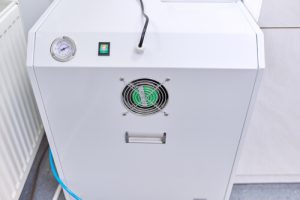Welcome to the fascinating world of dental vacuum pumps, a vital yet often overlooked component of dental clinics. Imagine the sense of safety and cleanliness in a dental office where procedures go seamlessly and the air remains pure. This scenario isn’t just about comfort—it’s about ensuring the highest health and safety standards for patients and dental teams. What role does a machine such as the dental vacuum pump play in achieving this?
Why should every dental practice consider investing in one? Let’s examine this essential tool closer, uncovering how it revolutionizes dental care by making visits safer and procedures more efficient.
Introduction to Dental Vacuum Pumps
Dental vacuum pumps are integral to modern dental practices, providing the essential service of removing saliva, blood, oil and debris from the patient’s mouth during various dental procedures. This ensures that the treatment area remains clean, which is vital for the patient’s safety and the success of the dental work.
Vacuum Pressure and Suction Power are critical components of dental vacuum pumps. These pumps are designed to efficiently remove fluids and solids from the oral cavity. The systems are calibrated to offer optimal suction without compromising patient comfort.
Wet vs. Dry Vacuum Pumps: Dental practices can choose between wet and dry systems, each with benefits. Dry vacuum pumps, known for their lower water consumption and compact design, offer an eco-friendly and space-saving solution suitable for modern dental offices.
Innovations in Technology: Many dental vacuum systems now incorporate rotary vanes and advanced filtration mechanisms. These innovations improve suction efficiency, extend the equipment’s lifespan, and ensure the capture of bacteria and debris, thereby enhancing the cleanliness of the dental office.
Noise and Power Efficiency: Newer dental vacuum pumps are designed to operate quietly and with minimal power consumption, making the dental office a more pleasant environment for patients and staff.
Multi-user Compatibility: High-capacity dental vacuum systems can support multiple treatment rooms simultaneously. This feature is essential for larger practices, allowing for seamless operation across various procedures.
How Dental Vacuum Pumps Work
Understanding the mechanics behind dental vacuum pumps is crucial for any dental professional looking to maintain a high standard of patient care and clinic efficiency. These systems are integral to the smooth operation of dental practices. Here’s a detailed look at how these vital pieces of equipment function:
Principle of Operation
Dental vacuum pumps create a suction force essential for removing saliva, blood, and debris from the patient’s mouth during dental procedures. Dental suction equipment ensures a clear working area for dentists and hygienists, enhancing patient comfort and procedure efficiency.
Suction Power and Vacuum Pressure
Its suction power and vacuum pressure measure the effectiveness of a dental vacuum pump. These parameters are finely tuned to balance the need for effective debris removal with patient safety.
Components and Technology
Key components include the motor, which powers the system, and rotary vanes, which enhance efficiency and longevity in some models. Filters are also critical, trapping bacteria and debris to prevent contamination.
Advantages of Dry Systems
Dry vacuum pumps, with their minimal water use and space-saving design, offer several advantages. They are more energy-efficient, produce less noise, and require less maintenance than wet systems, making them a desirable choice for modern dental practices.
Types of Dental Vacuum Pumps and Their Applications
 Understanding the types of dental vacuum pumps and their specific applications is pivotal for any dental practice aiming to optimize its operations and patient care. These pumps, central to the functionality of modern dental clinics, come in various forms, each designed to meet the unique demands of different dental procedures. Let’s delve into the types of dental vacuum pumps and explore their applications:
Understanding the types of dental vacuum pumps and their specific applications is pivotal for any dental practice aiming to optimize its operations and patient care. These pumps, central to the functionality of modern dental clinics, come in various forms, each designed to meet the unique demands of different dental procedures. Let’s delve into the types of dental vacuum pumps and explore their applications:
Wet Vacuum Pumps
Traditionally used in dental practices, wet vacuum pumps rely on water to create suction. Their application is widespread due to their reliability and familiarity within the dental community. However, their higher water consumption and operational costs gradually overshadow more efficient and environmentally friendly options.
Dry Vacuum Pumps
Dry vacuum pumps, which do not use water to generate suction, are gaining popularity for their efficiency and eco-friendly operation. This type is preferred for its lower utility costs, reduced maintenance, and minimal environmental impact. Its compact design allows for easier installation in dental clinics with limited space. Dry vacuum pumps are ideal for practices looking to reduce their carbon footprint while maintaining high standards of dental care.
Rotary Vane Vacuum Pumps
Rotary vane vacuum pumps are known for their durability and efficiency. They use a series of vanes in a rotating assembly to create vacuum suction. These pumps suit various dental procedures, offering consistent performance and longevity. They are particularly valued in busy practices for their reliability and ability to handle multiple simultaneous users.
Applications in Dental Practices
Dental vacuum pumps are indispensable for procedures requiring saliva and debris removal, such as cavity preparation, root canals, and general cleanings. They ensure a clear field of operation for dentists, enhance patient comfort, and prevent the spread of contaminants. The choice between wet and dry systems often depends on the practice’s specific needs, considering factors like patient volume, space availability, and environmental concerns.
Maintenance Tips for Dental Vacuum Pumps
 Maintaining quality dental vacuum pumps is crucial for ensuring their longevity and the safety of the dental vacuum system. Here’s a concise guide to keeping these essential devices in optimal condition:
Maintaining quality dental vacuum pumps is crucial for ensuring their longevity and the safety of the dental vacuum system. Here’s a concise guide to keeping these essential devices in optimal condition:
- Filter Replacement: Change filters regularly to prevent clogs and maintain suction efficiency. Follow the manufacturer’s guidelines for replacement intervals.
- Motor and Rotary Vanes Maintenance: Keep the motor and rotary vanes clean to avoid overheating and wear. Inspect them periodically for signs of damage.
- Leak Inspections: Check vacuum lines and connections for leaks to maintain maximum suction power.
- Professional Servicing: Schedule annual or bi-annual servicing with certified technicians for a comprehensive system check-up.
- Specific Care for Dry and Wet Systems: Monitor water usage in wet systems to prevent inefficiency. For dry systems, ensure air filters are clean and internal components are debris-free.
In wrapping up our exploration of dental vacuum pumps, it’s clear that these devices are not just a background feature in the dental clinic; they’re a cornerstone of modern dental practice. They ensure every visit is safe, clean, and efficient, from routine check-ups to more complex procedures. Whether you’re part of the dental community or a patient valuing high standards of care, the significance of the dental vacuum pump cannot be underestimated. It’s a critical investment in health, well-being, and dental services’ smooth flow and operation.
Ready to elevate your dental practice with the latest dental vacuum pump technology? This opportunity will enhance your clinic’s efficiency and patient safety. Call Cattani Compressors Australia today at (02) 8880 9257 and take the first step towards a more streamlined, safer dental care experience. Our experts are on hand to guide you through our range of dental suction pump solutions tailored to meet your needs. Don’t wait—transform your dental practice with the best in the business.
References
A Buyers’ Guide to Dental Vacuum Systems – Oral Health Group
https://www.oralhealthgroup.com/features/a-buyers-guide-to-dental-vacuum-systems/
An uncomfortable truth | BDJ In Practice
https://www.nature.com/articles/s41404-023-1988-8
Performance tests of vacuum pumps in small and large dental facilities
https://pubmed.ncbi.nlm.nih.gov/10825778/
Dental compressed air and vacuum systems
https://www.england.nhs.uk/wp-content/uploads/2021/05/HTM_2022_S1.pdf
Dental School Vacuum System Pump LOTO Procedure
https://ehs.unc.edu/wp-content/uploads/sites/229/2022/03/dental-school-vacuum-system-pump-loto-procedure-hvac-auxiliaries.pdf



